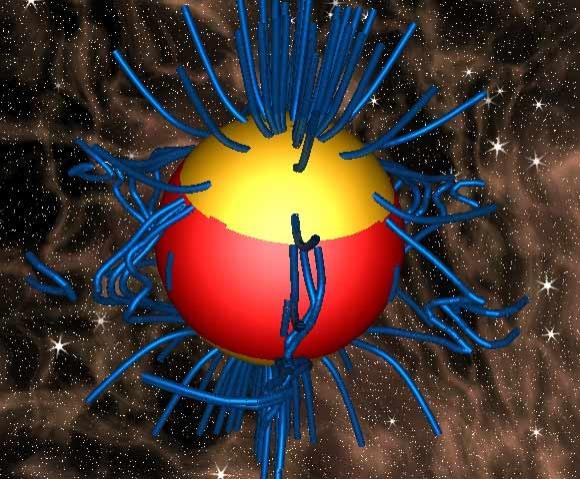Universe Today | Jon Voisey | 21 Dec 2010
Discovery of the first tau Sco analogues: HD 66665 and HD 63425 - V Petit et alMany classes of stars are named for an early, distinguished member of a certain type of stars. For example, Cepheid variables take their namesake from the periodic variable Delta Cephei, first recognized by John Goodricke, although Eta Aquillae, another Cepheid, was recognized as a periodic variable with the same period just before Delta Cephei. Since the time of Goodricke’s discovery, many more classes of objects have been discovered from T Tauri, to W Ursa Majoris, to Delta Scorpii.
But sometimes, stars must wait before more members of their class are discovered. Tau Scorpiiis a massive B0 star and one of the rare high mass stars for which magnetic fields have been measured. To distinguish it even further, studies have shown that its magnetic field is unusually complex, being much more tangled than most stars and not showing distinct dipoles. Additionally, this unusual star has been shown to have weaker stellar winds (and consequently, mass loss rates) than most B0 type stars, as well as spectral features that are simultaneously characteristic of stars on the main sequence and young giants. Meanwhile, the star is believed to be only a few million years old. A first step towards characterizing such odd objects is to find more. Fortunately, astronomers have discovered two more stars similar to Tau Scorpii.
The two new stars, HD 66665 and HD 63425, were first recognized as unusual from their spectra, taken by the Canada-France-Hawaii Telescope. Using these spectra, the team, led by Véronique Petit at West Chester University, recognized that these stars had the same peculiar winds as Tau Scorpii. While Petit’s group could not completely constrain the mass loss rates, they did place an upper limit on both, establishing that they too shared the “weak wind problem” in which the expected mass loss rate for such stars was roughly 20 times higher. This prompted the team to investigate each star for magnetic fields.
Although the team wasn’t able to fully analyze the magnetic fields during their observing run to determine just how unusual they were, the team did establish both stars did have magnetic fields present and that they were similar in strength to that of Tau Scorpii. These two pieces of information has led the team to conclude that HD 66665 and HD 63425, along with Tau Scorpii, constitute a new class of stars. Additional confirmation could come from similar conclusions on the age of the analogues.
Petit’s team doesn’t speculate as to the nature of this emerging class in this paper. However, an earlier work of which Petit was a co-author, examined Tau Scorpii specifically. In it, the team examined whether the unusual field was a “frozen in” fossil from formation, or actively produced by an unusual dynamo inside the star. Fields produced by dynamos require large portions of the interior of the star undergoing convection. Models of massive stars predict that convection is likely to be limited in such stars. Another key component is rotation. Tau Scorpii is an extremely slow rotator, so the team concluded that a dynamo is unlikely in this case. As such, the fossil-field theory was more likely. Further investigation of HD 66665 and HD 63425 will certainly be necessary to further compare these stars to Tau Scorpii.
- arXiv.org > astro-ph > arXiv:1012.4445 > 20 Dec 2010
- arXiv.org > astro-ph > arXiv:astro-ph/0606156 > 07 Jun 2006
